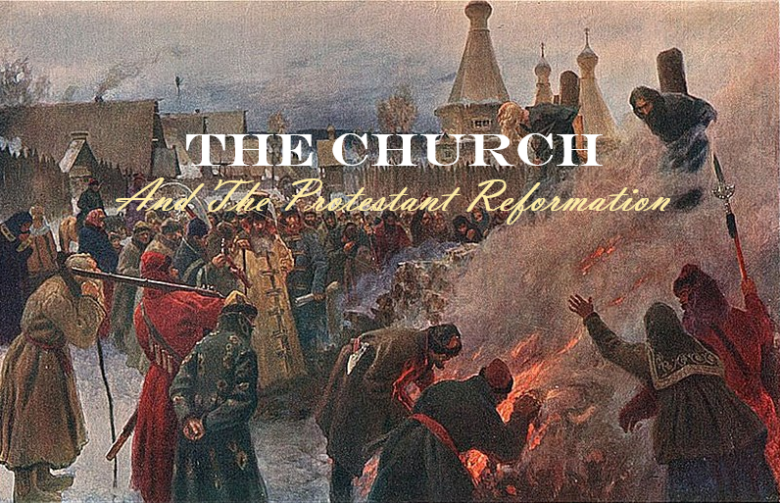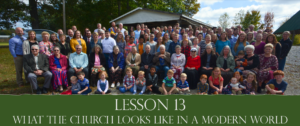The previous lesson briefly analyzed how that the Catholic Church fails to identify as the one Jesus said He would build. In our pursuit of finding the church of the Bible, the one described in Lessons 1-6 of this series, we now arrive at those denominations that sprang out of what is called the Protestant Reformation. In this study we must travel back in time to the early 1500’s.
What was the Protestant Reformation?
It’s all in the name. The Protestant Reformation was a religious movement that spread across every sector of Europe around the same time the Bible was being translated into the common person’s tongue. Up until the 1500’s, Bibles were scarce and only the educated could read Latin, the popular language of the Bible at that time. Then came along a Dutch Catholic priest named Desiderius Erasmus, a German Catholic monk named Martin Luther, and an English Catholic priest named William Tyndale. Luther and Tyndale took Erasmus’ recently composed transcript of the Greek New Testament, (the New Testament was originally written in Greek, not Latin) and these two men translated the Holy Scripture into the language of the farmer, storekeeper, and servant. For the first time in over 800 years the Bible could be read and understood by someone other than a Catholic bishop, king, or priest. What people discovered from reading the Bible for themselves is the very thing that ignited protests against the Roman Catholic Church and proceeding efforts to reform it (aka: the Protestant Reformation). The mother church had been exposed, and its effect would be more than felt.
What Needed Reforming?
That’s a great question; I’m glad you asked! There were many Catholic traditions that readers of Tyndale’s New Testament found to be heretical and utterly detestable: most popularly being the doctrines of transubstantiation, purgatory, and the ascribed supremacy of papal authority over Scripture itself. Perhaps the corruption of the Catholic Church from this period is best illustrated in the life of John Bainham, a knight of Gloucestershire, England. Bainham got his hands on a Tyndale New Testament, or maybe it’s more accurate to say the New Testament got its hands on Bainham. He was so taken by what he read and outraged by what he saw from the church in light of Scripture. Bainham openly denied the Catholic doctrines of purgatory, praying to saints, confession to priests, and the pope’s authority being placed above Scripture. For this “heresy” he was arrested and made to suffer until he recanted his beliefs and teachings. David Teems, in his book on Tyndale, says that Bainham was treated so severely in the Tower of London that he was left lame. Finally, under much duress, Bainham was suffered to sign a document stating the rejection of his beliefs. But this lasted less than a month. Bainham was too conscientious and quickly thereafter faced burning at the stake for heresy. He embraced the stake and confessed,
“First I say it is lawful for every man and woman to have God’s book in their mother tongue. Second, that the bishop of Rome is Antichrist…there is no purgatory…for our souls immediately go to heaven and rest with Jesus Christ for ever.” (John Bainham)
Hundreds of men and women would burn and/or be beheaded during this century for the same (see the executions of Thomas Cranmer, Hugh Latimer, Nicholas Ridley, William Tyndale, and John Tewkesbury for other similar accounts).
The Fallout
The grotesqueness of Rome and its attempt to extinguish the opposition did little more than fan the flame of the reformers. One of the most obvious marks of error in Roman Catholicism noted by the likes of Martin Luther, John Calvin, William Tyndale, and Ulrich Zwingili was the Catholic teaching and practice of justification by works of merit: the teaching that if a man does enough “good” works (i.e. prayers to enshrined saints, confessions to priests, self mutilation, etc.) he can overcome committed sin and merit God’s grace. Certainly this idea is outrageous. In fact, it was so outrageous to the men listed above that they went to the polar opposite end of the justification spectrum. Instead of something you earn, Luther famously taught there is absolutely nothing, whatsoever a man does to be justified outside of having faith towards God. Michael Reeves sums it up, “From the moment Luther understood from Romans 1 that God’s righteousness is an entirely unmerited gift, justification was the matter of the Reformation…justification was what made the Reformation the Reformation.” Luther was so convinced that ALL works were by nature meritorious, that he refused to teach from James 2 (i.e.- “You see then that a man is justified by works, and not by faith only.”), even declaring James to be uninspired. John Calvin went so far as to teach that God must give faith to the individual since man is so depraved, unable to do anything towards his own salvation (Irresistible Grace).
What’s Wrong?
What’s wrong with what the reformers were teaching? Let me start by making the disclaimer- Luther, Calvin, Zwingli, and especially Tyndale were brave, stalwart men. They did not teach and oppose Catholicism because it was the popular thing to do. There were times when it was indeed popular, but these men opposed the mother church when it meant life and death. Tyndale indeed did die for his beliefs on this matter. Nonetheless, sincerity is not the measure of truth or character. And so we must approach the question with honest hearts and open minds, “Did the reformers go too far in their response to the evil manifest in the Catholic church?”
Part 2 coming soon…
Resources- 1) Tyndale: the Man Who Gave God an English Voice by David Teems 2) The Unquenchable Flame by Michael Reeves


